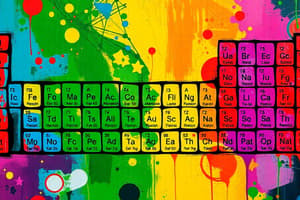Podcast
Questions and Answers
What are the three main components of an atom?
What are the three main components of an atom?
- Neutrons, electrons, and photons
- Neutrons, protons, and electrons
- Protons, electrons, and photons
- Protons, neutrons, and electrons (correct)
Which particle in an atom determines its identity?
Which particle in an atom determines its identity?
- Neutron
- Electron
- Photon
- Proton (correct)
What principle governs the arrangement of electrons in shells within an atom?
What principle governs the arrangement of electrons in shells within an atom?
- Newton's Law
- Pauli Exclusion Principle (correct)
- Bohr's Law
- Einstein's Rule
What occurs in a chemical reaction?
What occurs in a chemical reaction?
Which property can be affected by chemical reactions?
Which property can be affected by chemical reactions?
Which part of the atom contains positively charged protons and neutral neutrons?
Which part of the atom contains positively charged protons and neutral neutrons?
What determines the arrangement of elements in the periodic table?
What determines the arrangement of elements in the periodic table?
Which statement describes the octet rule?
Which statement describes the octet rule?
What do acids release into water solutions?
What do acids release into water solutions?
What is the conjugate base of acetic acid?
What is the conjugate base of acetic acid?
Which factor affects the strength of an acid or base?
Which factor affects the strength of an acid or base?
What is produced when hydrogen and oxygen gas combine?
What is produced when hydrogen and oxygen gas combine?
Flashcards are hidden until you start studying
Study Notes
Introduction
Chemistry is the scientific discipline that studies the properties, composition, and behavior of matter and its interactions with energy. At the heart of chemistry lies the understanding of the fundamental building blocks of matter: atoms and their compounds. This article focuses on key aspects of chemistry, delving into topics such as atomic structure, chemical reactions, the periodic table, and acids and bases.
Atomic Structure
Understanding atomic structure is crucial in chemistry as it provides insights into the composition and behavior of atoms. Atoms, the fundamental particles of matter, are composed of three main components: protons, neutrons, and electrons. The central nucleus of an atom contains positively charged protons and neutral neutrons, while negatively charged electrons orbit the nucleus in distinct energy levels or shells. The number of protons determines the identity of an atom, with higher atomic numbers corresponding to heavier elements. Electrons are arranged in shells in accordance with the Pauli exclusion principle, filling successive shells before any additional electrons can occupy lower ones.
Chemical Reactions
When atoms interact, they undergo chemical reactions, resulting in the formation or breaking of chemical bonds, leading to new substances. These reactions involve the rearrangement of electron structures and can cause changes in macroscopic properties such as color, odor, melting point, or boiling point. For example, the combination of hydrogen and oxygen gas produces water vapor, which is a colorless and odorless gas formed due to sharing electrons between hydrogen and oxygen atoms.
Periodic Table
To better understand the organization and properties of elements, chemists developed the periodic table. This chart displays elements based on increasing atomic numbers, grouping together those with similar chemical behaviors. Elements within the same group have similar physical and chemical characteristics due to the number of electrons in outer shells. The arrangement of electron structures follows a pattern known as the octet rule, where atoms tend to form stable compounds when their outermost shells contain eight electrons.
Acids and Bases
Acids and bases play essential roles in many natural processes and industrial applications. Acids are substances that release hydrogen ions (protons) into water solutions, while bases accept hydrogen ions. These interactions result in acid-base reactions, often involving equilibria between conjugate pairs such as acetic acid and its base form acetate ion. The strength of an acid or base depends on factors like pH, concentration, and temperature, providing a means to classify different species based on their ability to donate or accept protons.
Studying That Suits You
Use AI to generate personalized quizzes and flashcards to suit your learning preferences.




